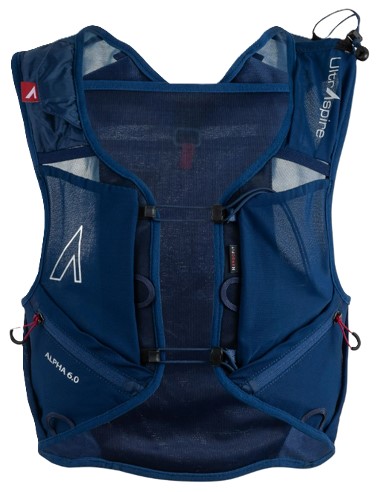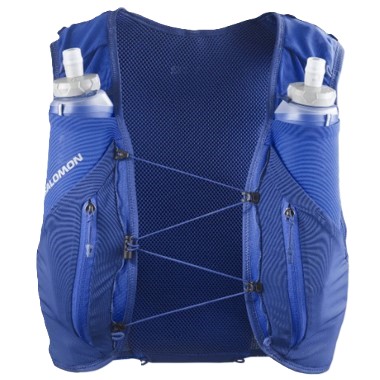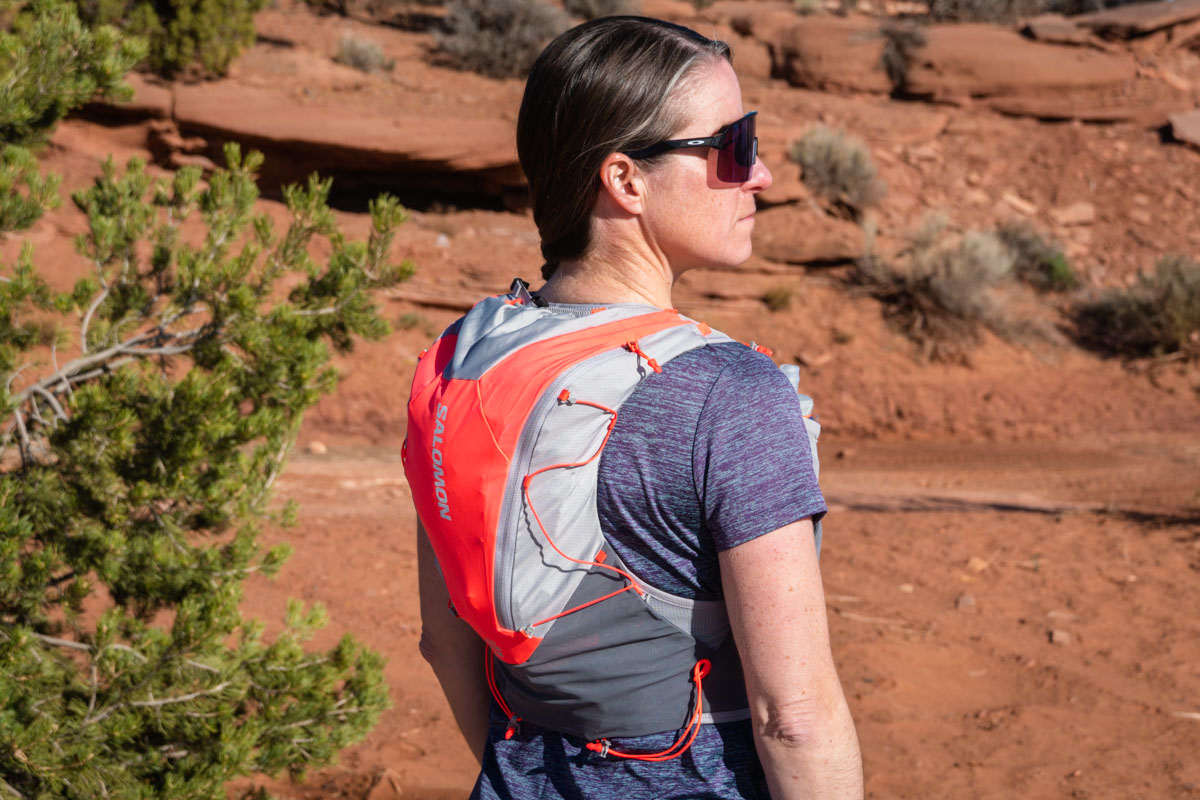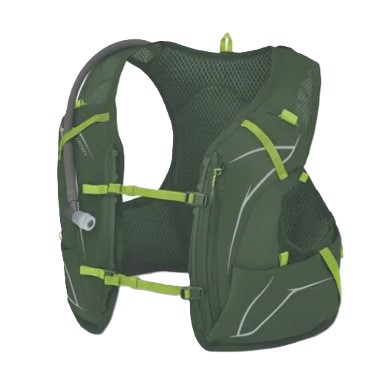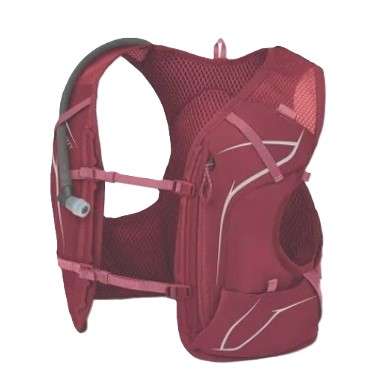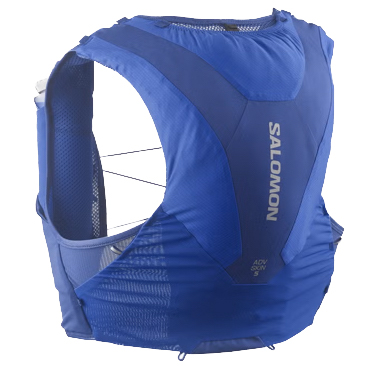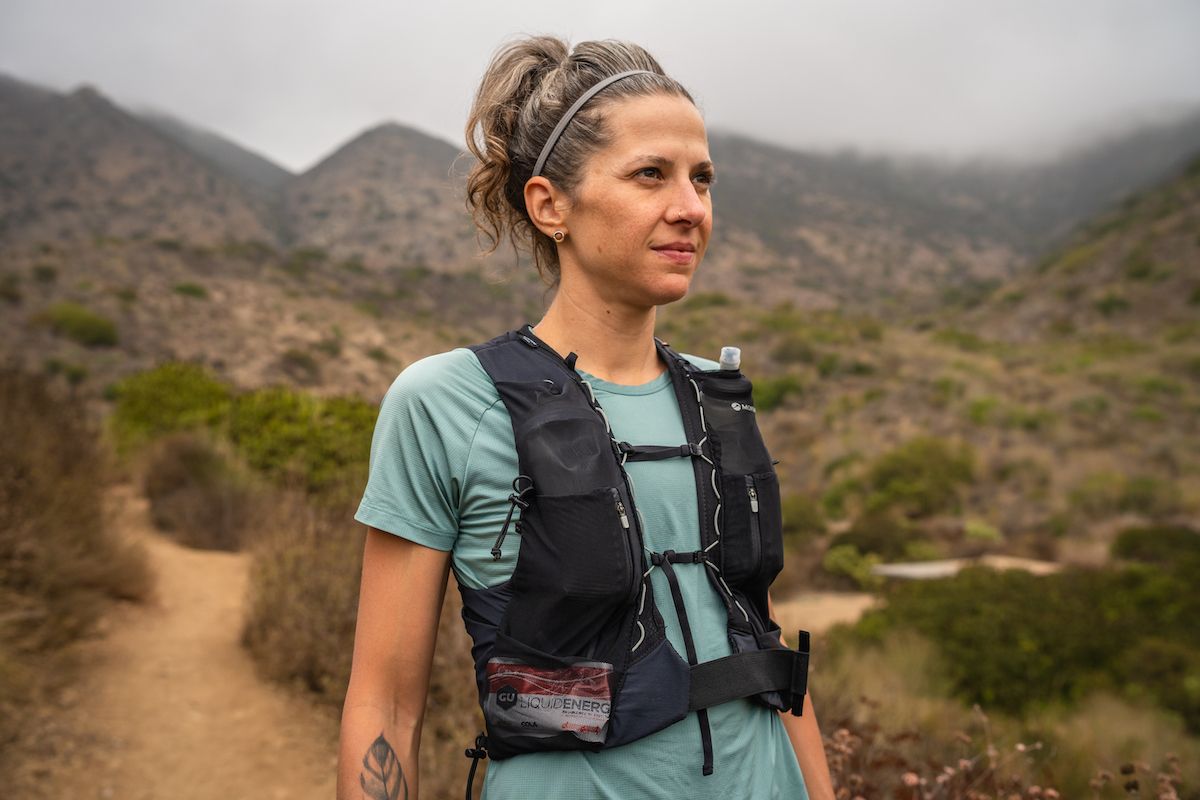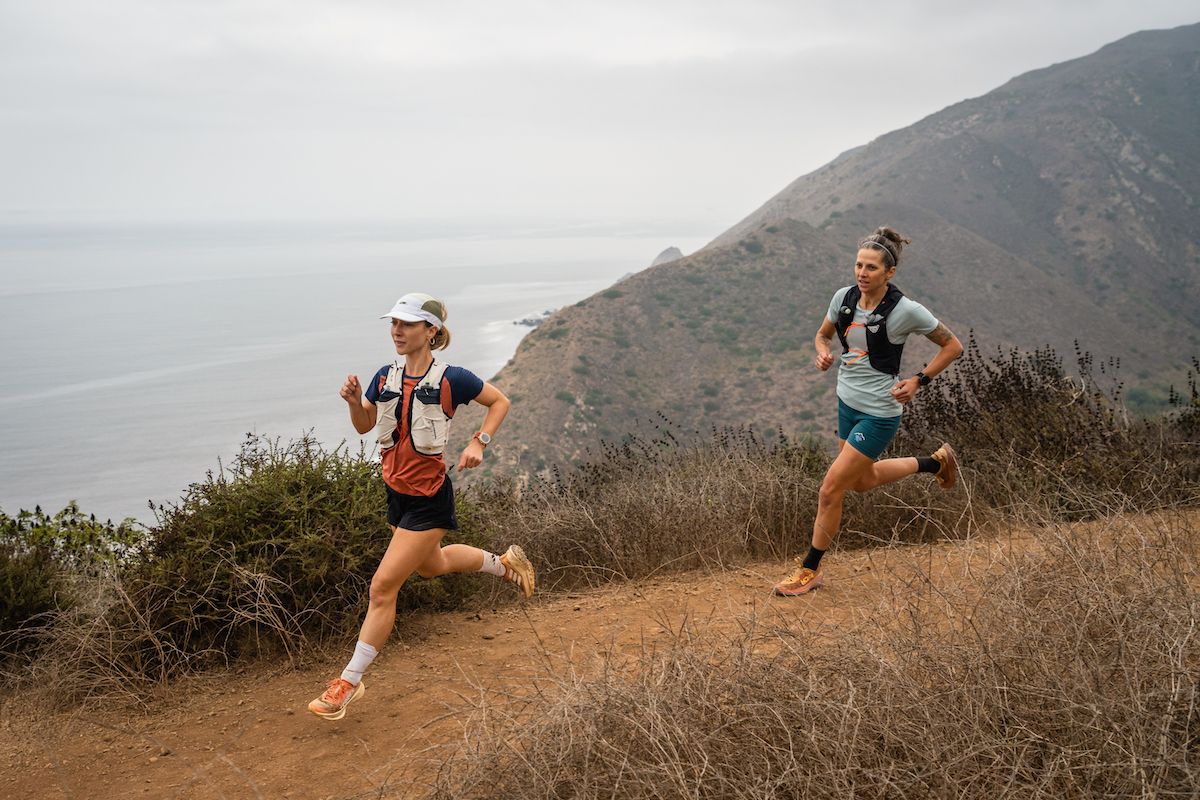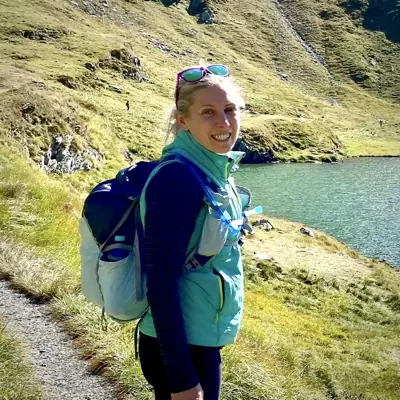
iRunFar’s Meghan Hicks (front) and Anna Frost testing running vests in the French Alps. Photo: iRunFar/Eszter Horanyi
The running vest, also called a hydration pack or hydration vest, is one of the most important parts of a runner’s gear collection. The best running vests can easily carry the hydration you need for your run, as well as snacks, extra layers, a phone, and anything else you need — all while keeping everything organized and easily accessible. There are heaps of running vest options on the market these days, and choosing the best hydration pack for running can feel overwhelming. Whether running for an hour or heading into the mountains for an all-day outing where you’ll need a lot more gear, there’s an excellent option out there.
Although a handheld water bottle or a running belt might suffice for a shorter run, a hydration vest can help you comfortably carry food, hydration, communication devices, first aid, layers, trekking poles, and more.
There are packs ranging from minimalist designs intended for racing to those that can hold everything you need for a full-day, unsupported run through the mountains. Our team of trail runners scoured the market for the best hydration packs for running and took the most promising out on all sorts of terrain to test their comfort, functionality, and durability so that we can help make your search for the perfect pack easier.
Ultimately, we chose the Patagonia Slope Runner Vest as our favorite small running vest, and the UltrAspire Alpha 6.0 Race Vest for longer runs that require more gear. When it came to carrying everything and the kitchen sink, our testers opted for the Salomon Adv Skin 12 running vest. If you need an even bigger pack, check out our Best Fastpacking Packs guide.
For more background information about the best running vests, see our buying advice, testing methodology, and frequently asked questions below the picks.
Best Running Vests of 2025
- Best Running Vest— Small: Patagonia Slope Runner Vest
- Best Running Vest — Medium: UltrAspire Alpha 6.0 Race Vest
- Best Running Vest — Large: Salomon Adv Skin 12
- Best Budget Running Vest: UltrAspire Spry 5.0
- Other Top Running Vests: Osprey Duro 1.5 and Osprey Dyna 1.5, Salomon Adv Skin 5, CamelBak Zephyr Pro Vest, USWE Pace 8L Trail Running Vest

A properly sized hydration pack can carry everything you need for a mountain run. Photo: iRunFar/Eszter Horanyi
Best Running Vest — Small: Patagonia Slope Runner Vest ($170)
- Breathable
- Simple design
- Easy to replace bottles while wearing
Cons:
- Clasp design is finicky and not our favorite
- Small, loose items in the back pockets jostle while running
We love the Patagonia Slope Runner Vest for its lightweight comfort, breathability, and easy functionality. It’s the perfect little pack if you want to grab two soft flasks, a handful of snacks, a jacket, and just go. Its minimalist design means it has everything you need and nothing extra to complicate things.
This pack can be adjusted using two front sternum straps, two side bungee cords, and two bungee cords at the shoulders. Once adjusted to a comfortable fit, we found that this pack didn’t bounce, regardless of how full or empty we had it. The body is made of a thin, stretchy, and breathable mesh, allowing you to carry plenty of gear without overheating.
The running vest comes with two Patagonia-branded 500-milliliter soft flasks. Hydrapak manufactures these flasks, meaning the tops are interchangeable with most other flasks in the running market. The flasks fit securely inside two front pockets and can easily slide in and out for refilling, even while wearing the loaded pack. Unlike some vests, these pockets will hold flasks from just about any brand without difficulty. Two additional stretchy mesh pockets on the front of the pack can hold plenty of nutrition, gloves, a headlamp, and other supplies.
A horizontal mesh sleeve across the back is excellent for carrying a lightweight jacket, hat, gloves, or extra food. Items in this pocket are easily accessible without taking the pack off. However, one thing that bothered us was that if we only had gels or nutrition in the back pocket, they would bounce around, though nothing ever fell out during testing.
Above this mesh sleeve is another pocket with a zippered closure. This pocket is ideal for securing items you want to carry on a run but do not need easy access, such as a first-aid kit or satellite communication device. Other details on this pack include trekking pole attachments on the lower back and each side in the front. iRunFar recommends carrying poles on the back of the pack to reduce the risk of injury in case of a fall.
Our only gripe with this pack is the hooks on the front sternum straps, which we found to be fiddly and difficult to attach. A simple buckle system like that on many other vests in this guide is easier to use, and the bungee-and-hook system on Salomon packs still feels the most streamlined.
You can read more about the specifics of this vest in our in-depth Patagonia Slope Runner Vest review.
Gear Capacity: About 3 liters | Liquid Capacity: 1 liter | Hydration Carrying Method: Two 500-milliliter Hydrapak soft flasks (included) | Model Options: Unisex
Shop the Patagonia Slope Runner VestBest Running Vest — Medium: UltrAspire Alpha 6.0 Race Vest ($150)
- Comfortable harness and easy-to-use front cinch closure eliminate pressure points and keep the pack stable
- Less compressive fit than other brands
- Many thoughtful details and well-designed storage compartments
- Affordable and good value
Cons:
- Heavier material increases weight and retains some heat
- Front pocket layout isn’t our favorite
As a mid-volume running vest, the UltrAspire Alpha 6.0 Race Vest bridges the gap between wanting to carry the bare minimum but not quite needing the capacity for a full-day unsupported journey. This pack is an excellent size for a three-plus-hour run or a supported ultramarathon where you may need to go a couple of hours between aid stations. The 6-liter capacity makes it an excellent option for ultras that don’t have an extensive gear list.
The curved and angled shoulder straps of the UltrAspire ErgoFit harness design are comfortable, and the system lowers the center of gravity of the vest to reduce neck fatigue, improve weight distribution and stability, and enhance the arm’s range of motion. This vest sits lower than most Salomon packs, and the shoulder straps stay away from the back of the neck, minimizing the chance of chafing. This vest fits snugly without feeling constricting when breathing deeply.
The front of the pack holds a pair of 500-milliliter soft flasks and has two large pockets that can fit quick-access items like food and gels. The pockets fit flasks from a variety of brands, including the longer and thinner Salomon flasks. Bungee loops at the top of the pockets keep flasks from slipping down as you drink your water. It’s worth noting that there are two additional pockets underneath the flask pockets, which could be useful if you’re not carrying water, but they feel impossible to access and use when there are full flasks in the vest.
Since the pockets are lower on the chest than on many other hydration vests, you must remove the bottles or flasks to take a drink. While this may annoy some, the pockets are wide enough to make reinserting the flasks easy. We decided that it wasn’t a deal-breaker for us. Two zippered side pockets under the arms will fit some calories and securely keep smaller items in place.
The rear compartment spans the length of the pack, providing extra storage capacity, and fits the included 2-liter hydration bladder in a separate sleeve with a removable Mylar-insulated insert that can help keep your water cold. A pass-through pocket and elastic cinch cord provide additional quick-access rear storage for an extra layer or snack.
This vest received a few thoughtful updates, the biggest being that UltrAspire fixed a pole-carrying system that simply didn’t work very well on the previous version of this vest. You can still secure poles on the bottom of the main rear pocket, but the bungees are situated much farther apart and a bit higher on the vest and hold poles much more securely.
The back has lightweight honeycomb mesh next to the body that wicks moisture well, but the other vest materials are thicker than those of similar packs. We found that this vest didn’t breathe quite as well as a similarly sized Salomon pack. This may improve its long-term durability, but it makes the pack heavier. The profile of this pack can feel long for smaller runners or those with a shorter torso.
The elastic cinch cord sternum closure uses a single hook, which minimizes fumbling with a complicated buckle with tired or cold fingers, and we found it to be quite comfortable.
To learn more about this pack, check out our UltrAspire Alpha 6.0 Race Vest review.
Gear Capacity: 6 liters | Liquid Capacity: 3 liters | Hydration Carrying Method: Two 500-milliliter flasks (included) or 2-liter hydration bladder (sold separately) | Model Options: Unisex
Shop the UltrAspire Alpha 6.0 Race VestBest Running Vest — Large: Salomon Adv Skin 12 ($165)
- It is just as comfortable full as it is with minimal gear
- Stretch compartments hold a lot of gear and distribute weight well
- Stretch panels conform snugly to the body without compressing
Cons:
- Flasks can be difficult to get back into their sleeves when removed
Look around the starting line of almost any ultramarathon, and you will see many runners wearing the Salomon Adv Skin 12 running vest. This is for good reason! Salomon released an updated version of this vest in 2025 with many smaller tweaks, and we’re mostly pleased with the changes.
The previous version of this 12-liter vest was our testers’ hands-down favorite in the high-volume running vest category. Notably, Salomon redesigned the pockets on the women’s version of the vest, moving them further up so that they could be used with regular flasks instead of those with long straws. Many of our women testers prefered the unisex version of the previous pack simply because of the flask-carrying system, so this is a big improvement for the women’s pack.
We think this is the perfect pack for long days on the trail and self-supported adventures where you’ll carry your gear and nutrition for the entire day. It can fit a massive amount of cargo and wears equally as comfortably when empty.
The inner mesh of the pack is slightly different from the old one, with a honeycomb mesh with bigger perforations. It uses the same Sensifit construction to haul a serious amount of gear while maintaining a snug vest-like fit. The front pocket setup is essentially the same as before, with two flask pockets that hold the included 500-milliliter Salomon soft flasks. These are overlaid with two other stretchy pockets that you access from the top, and then each side also has a zippered pocket to hold small do-not-lose essentials.
These zippered pockets can securely hold fairly large phones. Our testers found the flasks were a little tricky to get back into their sleeves compared to other packs with wider flask pockets. The pockets are designed to use Salomon’s longer and skinnier flasks, so it’s harder to mix and match flasks from other brands with this vest.
Salomon got rid of the partition in the rear bladder pocket, so now a bladder will sit directly against the mesh material of the inner part of the vest. We suspect this will result in cold water getting warmer more quickly since it’s closer to the skin. A vertical side zipper accesses the large rear main compartment with impressive stretch and bungee compression cords on either side of the back help stabilize the load.
A smaller stuff pocket inside the main pocket can fit an emergency blanket, gloves, hat, or small jacket, and the pass-through tunnel pocket across the bottom of the rear compartment provides additional storage for easy access on the go. Because this pack is just as comfortable when it’s empty as when we stuffed it to the gills, it’s an excellent option for people wanting a single pack to do it all.
There are multiple attachment options for carrying trekking poles on the front and rear, and Salomon upgraded the rear pole bungees by changing their angle on the pack and making them tighten from the bottom. You can also easily attach a separate Salomon quiver to hold poles.
To learn more, check out our in-depth Salomon Adv Skin 12 review.
Gear Capacity: 12 liters | Liquid Capacity: 2.5 liters | Hydration Carrying Method: Two 500-milliliter soft flasks (included), 1.5-liter hydration bladder (sold separately) | Model Options: Unisex
Shop the Salomon Adv Skin 12 Hydration Vest - Unisex Shop the Salomon Adv Skin 12 Hydration Vest - Women'sBest Budget Running Vest: UltrAspire Spry 5.0 Race Vest ($90)
- Lightweight and breathable
- Very affordable, even with the extra cost of bottles or a hydration bladder
- Quality materials and improved pocket setup
Cons:
- One-size-fits-most sizing may not accommodate all bodies
- Rear storage is inaccessible while wearing the pack
The UltrAspire Spry 5.0 Race Vest is a 3.5-liter capacity pack that offers excellent storage and features at an affordable price.
The materials are breathable and lightweight, and there are just enough pockets to hold your essentials for anything from a half marathon to a fast, well-supported ultra run. In addition to being our budget pick, this vest also rated very highly overall in the small vest testing category.
Our main tester, who wrote our UltrAspire Spry 3.0 review and the UltrAspire Spry 4.0 review, says this version is the best yet. The flask pockets were updated to be vertical, and our tester says they are finally big enough to fit any soft flasks. These front pockets are also great for holding snacks and other small items. The pockets overlaying the flask pockets are perfect for securely stashing snacks, trash, and other small items.
A single rear pocket, including a sweatproof liner, can fit a 1-liter bladder. The pack also has many smaller pockets, including one with a magnetic closure. An external elastic shock cord on the back can stash a jacket.
This vest utilizes the same ErgoFit harness and an elastic chest strap-and-hook closure as the above-reviewed UltrAspire Alpha 6.0 Race Vest. The biggest upgrade to this vest is its fit. For the first time, the side straps of the vest are stretchy and soft, making this one-size-fits-most vest more accommodating to various body shapes and sizes. According to UltrAspire’s size chart, it can fit chest sizes from 26 to 48 inches.
The vest doesn’t include flasks or a hydration bladder, which will add cost if you want them. Even if you have to buy flasks or a bladder, this vest is still more affordable than most similar setups.
Keep an eye on this space for a complete review of the new UltrAspire Spry 5.0 Race Vest.
Gear Capacity: 3.5 liters | Liquid Capacity: 2 liters | Hydration Carrying Method: Two 500-milliliter flasks or hybrid bottles in the front and a 1-liter bladder in the rear pocket. Flasks and bladder sold separately | Model Options: Unisex, one size fits most
Shop the UltrAspire Spry 5.0 Race VestOther Top Running Vests
Osprey Duro 1.5 ($120) and Osprey Dyna 1.5 ($120)
Pros:
- Generous liquid-carrying capacity for its size
- Easily repositioned sternum straps to dial in the fit
Cons:
- The material is thicker and heavier than some other packs
The Osprey Duro 1.5 and women-specific Osprey Dyna 1.5 are low-volume, race-ready running vests with everything you need for short and fast days on the trail. A rear zip compartment fits the included 1.5-liter hydration reservoir, and two large front stretch pockets can fit nutrition, small bits of gear, or Osprey’s 500-milliliter or 360-milliliter soft flasks. However, you’ll have to purchase those separately.
Our testers noted that the rear pocket could not fit additional gear with a full hydration bladder, but there is an exterior bungee cinch cord to carry a jacket or extra layer. Two stretch pockets under the arms can fit a buff, a hat, gloves, or other smaller items. There is also a smaller front zip pocket to hold a few other small items securely. The rear hydration bladder compartment has a diagonal zipper opening. You can route the hydration bladder hose through this zipper on the right or a separate port on the left.
The sternum strap secures with plastic snaps that clip on each shoulder strap. These clips can move up and down, making it easy to adjust the positioning for your comfort. Our testers found the arm holes to run a little on the small side, so you may need to size up if you have broader arms or shoulders. The material is a little thicker and heavier than some of the other tested packs, but it is very durable while maintaining breathability.
For a small-capacity pack, it includes many thoughtful details and has a hydration capacity on par with many larger packs.
If you love the fit and function of this running vest but are looking for something with more gear storage capacity, Osprey also offers a 6-liter version of the Duro and Dyna that you can learn more about in our Osprey Dyna 6/Duro 6 review.
Gear Capacity: 1.5 liters | Liquid Capacity: 2.5 liters | Hydration Carrying Method: 1.5-liter hydration bladder (included) and can fit two 360-milliliter or 500-milliliter soft flasks in front pockets (sold separately) | Model Options: Gender-specific, Duro (men’s) and Dyna (women’s)
Shop the Osprey Duro 1.5Shop the Osprey Dyna 1.5
Salomon Adv Skin 5 ($145)
- Updated lightweight material
- Easy-access rear pass-through pocket
- Sleek, body-hugging design
Cons:
- Missing the old top stuff pocket
Like its larger counterpart reviewed above, the Salomon Adv Skin 5 is a newly updated version of a well-loved vest that is seen on start lines and trails around the world. Perhaps what sets the Salomon packs apart from the rest is their ability to smoothly wrap around the torso with their SensiFit construction. While some of the materials of the pack have changed, including a tighter-weave mesh on the shoulder straps, the pack maintains its ability to ride without bouncing, whether it’s empty or stuffed full. The front closure system, consisting of a single stretchy cord that reaches across the chest twice and is tightened with a single toggle, remains one of the simplest and most functional closure systems on the market.
The vest has several easily accessible pockets. On the shoulder straps are two soft flask pockets specifically shaped to hold Salomon’s soft flasks. The unique shape of these pockets is a drawback to the vest, as it’s hard to mix and match flasks from other companies, as they tend to be too wide to fit easily into the pockets. Bungee cords at the top of each pocket wrap around the top of the flask and keep them from falling into the pocket as they empty. Another pocket overlays the flask pocket and securely holds smaller items or a phone. We found that we could easily stuff a few gels and other nutrition in these pockets and never worried about them falling out. A small zippered pocket on the left shoulder strap holds those items you really don’t want to lose — like your car key.
Updated in this version of the pack is the pass-through pocket on the bottom rear. Salomon tweaked the angle of the openings of this pocket, reducing its overall volume, but perhaps making it a bit more accessible. It’s big enough to fit a jacket or a hat and gloves, and we found it to be easy to reach while on the move. Unfortunately, Salomon removed the top external pocket that we used to stuff a jacket or other bulky items for access on the go. The main rear pocket has a slightly smaller opening than the previous version of the vest. A bladder sleeve, which can fit a 1.5-liter bladder (sold separately), sits within this main compartment.
Unfortunately, there isn’t a built-in pole attachment system in this vest, so if you want to be able to stow you’re poles, you’ll have to purchase Salomon’s quiver to attach to the back.
We loved the previous version of this vest because it was sleek, functional, and didn’t bounce. We’ve found that most of the updates to the vest push it to be even better, though we’re not convinced on the redesign of the rear pockets. The material is light and breathable, and it provides just enough structure to stay comfortable at any speed.
It’s worth noting that this pack only comes in a unisex model. While the sizing is consistent with normal men’s pack measurements, the women on our testing team found that they had to size down. Check Salomon’s website for sizing recommendations, especially if you tend to be between sizes.
Gear Capacity: 5 liters | Liquid Capacity: 1 liter | Hydration Carrying Method: Two 15-ounce soft flasks (included) | Model Options: Unisex
Shop the Salomon Adv Skin 5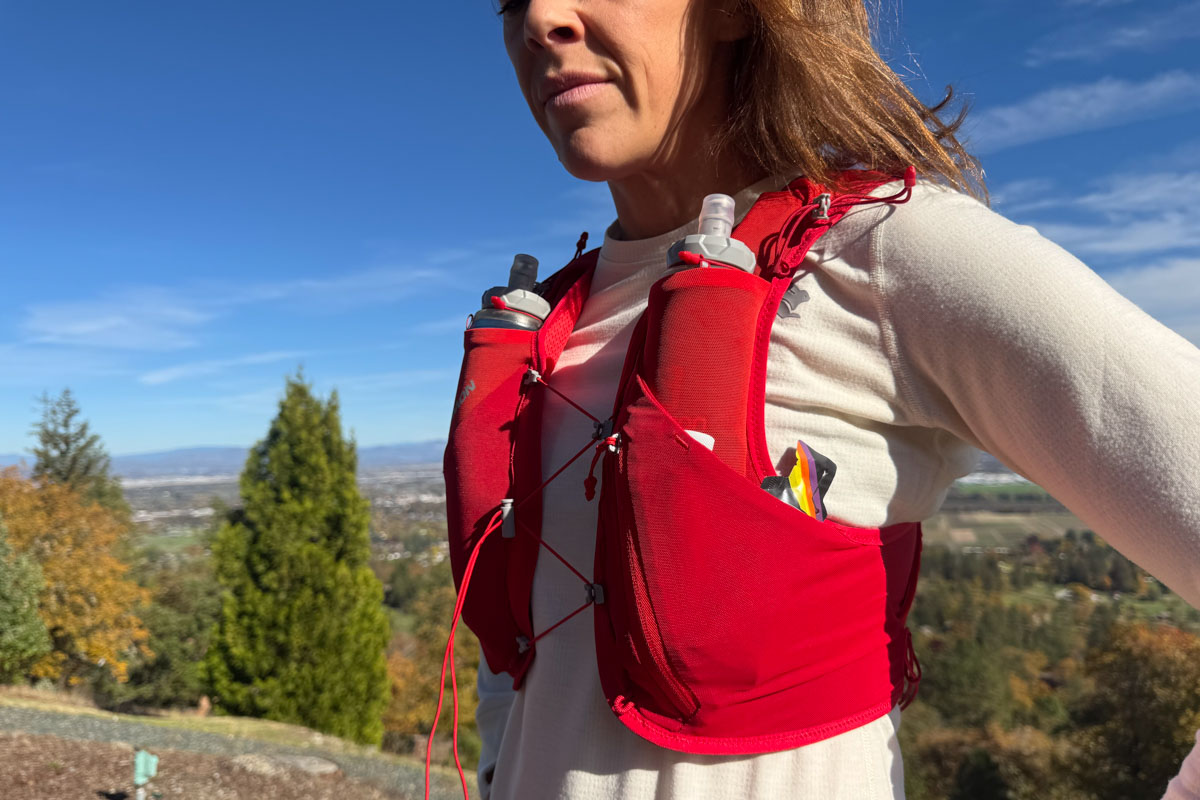
The Salomon Adv Skin 5 has plenty of space for soft flasks and nutrition. Photo: iRunFar/Annie Behrend
CamelBak Zephyr Pro Vest ($160)
- Lightweight
- Comfortable
- Easy to adjust
Cons:
- Doesn’t fit non-CamelBak flasks well
The CamelBak Zephyr Pro Vest is a mid- to large-sized hydration pack that works well for half- to full-day running adventures. It’s lightweight, with light colors and breathable mesh that keep it from feeling too hot. It comes in unisex and women’s versions with the same pocket layout but slightly different shapes and sizing. We tested both.
This running vest has several front pockets for keeping nutrition and other small essentials close at hand. Two mesh pockets hold CamelBak’s soft flasks, which come with the pack. One of our only gripes about this vest is that we’ve found that the CamelBak flasks tend to leak unless you really crank the lids on tightly.
Two zippered pockets are large enough for a phone, and one side has a clip to secure a car or house key within the zippered pocket. Finally, the front right side has one more small pocket to hold another gel or two. We were impressed with how much we could carry in the front of this pack.
A zippered pocket on the back is large enough for a jacket, first-aid kit, gloves, headlamp, and other gear for a full day out. If you’re using trekking poles, this pack has a removable, stowable quiver. Unfortunately, this is the only way to store poles on this pack, so if you don’t like the quiver system, you’re out of luck.
There are several options for carrying water, though. In addition to carrying two soft flasks in the front pocket, this pack can accommodate a 2-liter bladder (not included) and has webbing loops for securing the tube on each shoulder strap.
Unlike many hydration packs, this one has additional adjustment straps under the arms in addition to the traditional sternum straps. You can tighten these extra straps for bounce-free comfort. iRunFar testers appreciated that this vest was comfortable and easy to adjust and could fit a variety of body shapes and sizes. Other thoughtful details on this pack include reflective accents and a built-in safety whistle.
Our biggest gripe with this running vest is that the front hydration pockets are sized specifically for CamelBak’s soft flasks and are too short and wide for the standard Hydrapak soft flasks used in almost every other running vest. This makes it challenging to swap fresh water bottles quickly in a race, for example. That said, this may not be an issue if you prefer running with a bladder or are happy using the included CamelBak flasks.
Gear Capacity: 11 liters | Liquid Capacity: 1 liter | Hydration Carrying Method: Two 17-ounce soft flasks (included) | Model Options: Unisex and women’s-specific models
Shop the CamelBak Zephyr Pro VestShop the Women's CamelBak Zephyr Pro Vest
USWE Pace 8L Trail Running Vest ($155)
- Simple chest buckle and elastic side cords for easy adjustments
- Harness design eliminates bounce without feeling tight or constrictive
- Lightweight and breathable
Cons:
- Flasks have narrow openings that are hard to refill, and straws can shift and bounce around
- Rear storage is not easily accessible while wearing the pack
- The only pole-carrying option is across the front of the vest
The Swedish company USWE (pronounced “you-swii”) originated in the off-road motorcycle and bicycle world. Their foray into running hydration packs includes the USWE Pace 8L Trail Running Vest. Their experience and innovation in other outdoor spaces have led to some unique features that make this vest stand out in the mid-volume pack category.
This 8-liter running vest features USWE’s signature “No Dancing Monkey” harness system, providing a secure fit with no bounce. The front closure consists of one large circular buckle that our testers praised for its simplicity and ease of use. The pack’s adjustment points are elastic draw cords on the sides that cinch to tighten the fit without constricting breathing.
The material is very lightweight, stretchy, and comfortable, expanding easily to accommodate gear.
Two front pockets carry the included pair of 500-milliliter soft flasks. These are placed lower on the body and have attached drinking straws to allow for sipping on the go without having to remove the flask. The flasks have relatively small openings, which we found inconvenient for refilling, especially if using an electrolyte powder or drink mix. Two stretch pockets over the flask pockets are nicely expandable and can fit a cellphone, gels, and other smaller items.
The rear compartment can fit a 2-liter bladder (not included) and utilizes two pull-tight straps on the shoulders to compress the bladder, securing it and preventing movement and bouncing. Two zippered pockets along the lower rear of the pack provide secure storage. These overlie each other and can be challenging to reach with the pack on, making them less convenient than an open-ended pass-through pocket.
One of these compartments has a zipper opening on the bottom, which could result in lost gear if not fully zipped.
The trekking pole attachment sits diagonally across the front of the pack, which can interfere with the storage pockets and may be uncomfortable for runners with narrow builds or larger chests. At iRunFar, we also discourage the storage of trekking poles on the front of the body due to the risk of injury in case of a fall, and we don’t like this pack’s system.
If you like the fit and design of this vest but are looking for a lower-capacity race-ready vest, USWE also makes a 2-liter version with the same design and fit but without the larger rear pocket. You can check it out at our USWE Pace 2 Running Vest review.
Gear Capacity: 8 liters | Liquid Capacity: 3 liters | Hydration Carrying Method: Two 500-milliliter straw soft flasks (included) and can fit a 2-liter bladder (sold separately) in the rear | Model Options: Unisex
Shop the USWE Pace 8L Trail Running VestComparing the Best Running Vests
| RUNNING VEST | PRICE | GEAR CAPACITY | LIQUID CAPACITY | WEIGHT |
| Patagonia Slope Runner Vest | $170 | 3 liters | 1 liter | 6.8 ounces |
| UltrAspire Alpha 6.0 Race Vest | $150 | 6 liters | 3 liters | 8.8 ounces |
| Salomon Adv Skin 12 | $165 | 12 liters | 1 liter | 9.8 ounces |
| UltrAspire Spry 5.0 Race Vest | $90 | 3.5 liters | 2 liter | 7.5 ounces |
| Osprey Duro 1.5/Dyna 1.5 | $120 | 1.5 liters | 1.5 liters | 7.0 ounces |
| Salomon Adv Skin 5 | $145 | 5 liters | 1 liter | 6.9 ounces |
| CamelBak Zephyr Pro Vest | $160 | 11 liters | 1 liter | 9.1 ounces |
| USWE Pace 8L Trail Running Vest | $155 | 8 liters | 1 liter | 9.1 ounces |
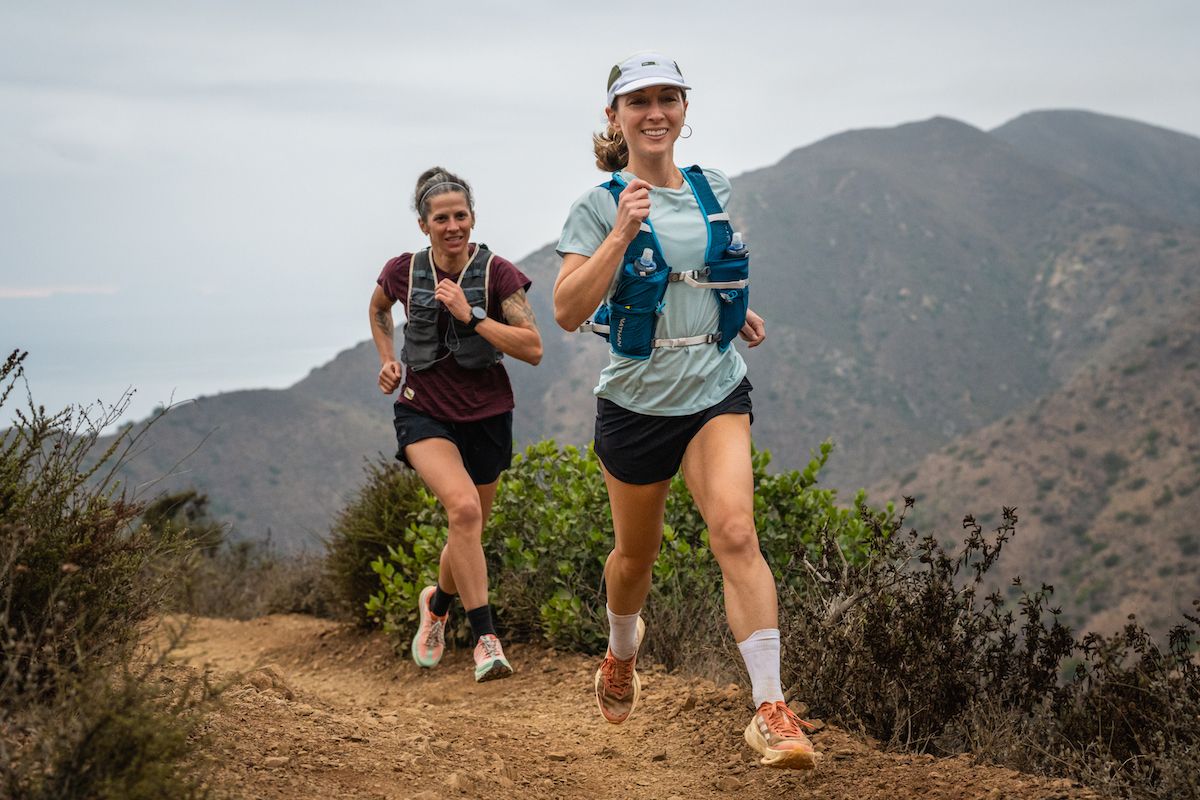
There are several factors to consider when choosing the best running vest. Photo: iRunFar/Eszter Horanyi
Buyer’s Guide: How to Choose the Best Running Vest
Vest Capacity
One of the main differences between the best running vests on the market is their capacity. Brands typically measure pack capacity in liters, much like a hiking or backpacking pack. Running hydration vests are generally much smaller than a traditional backpack and are designed to be form-fitting and vest-like to keep the pack from bouncing around.
Brands typically break up storage capacity into multiple pockets and compartments across the back and front shoulder straps instead of having one large rear pocket like a traditional backpack.
For shorter runs of less than two hours or a race with frequent access to aid stations, a pack with two to five liters of capacity, like the Patagonia Slope Runner Vest or Salomon Adv Skin 5, will be adequate to carry your hydration, food, and essentials.
For runs that are in the 3- to 6-hour range or in more challenging or slow-going terrain, one of the midsize packs, such as the USWE Pace 8L Trail Running Vest or UltrAspire Alpha 6.0 Race Vest, will give you a little extra storage space for gear and liquid.
For all-day adventures or runs in more remote and extreme terrain, which require extra gear and layers to guard against changing weather, a larger pack in the 12- to 15-liter range, like the Salomon Adv Skin 12, will be needed. The CamelBak Zephyr Pro Vest is also big enough for many all-day self-supported runs. If you are considering a race with a mandatory kit, a larger capacity pack is the best choice for stowing everything you’ll be required to carry.
Running-specific hydration packs max out in the 15-liter capacity range. If you are looking for a larger capacity pack for a longer or multi-day adventure, check out our Best Fastpacking Packs guide, as these will better serve the needs of that type of run or hike. That said, some on the iRunFar team are willing to engage in “shiver bivys” for overnight trips and can fit all their gear into a 12-liter pack.

Regardless of the terrain you run on, you want a running pack that will fit snugly and securely. Photo: iRunFar/Eszter Horanyi
Fit and Adjustability
Running hydration packs are close-fitting, with a vest-like wraparound style that sits higher on your torso than a traditional backpack. This fit makes it easier to access storage on the go and keeps the pack close to your body to prevent it from shifting and moving around when you run, which can cause chafing and even bruising over time.
The best running vests feature stretchy materials so they can move with you while you are running and breathing. They typically have at least one point of adjustment — most often an adjustable chest strap that tightens and loosens the pack easily on the fly. The USWE Pace 8L Trail Running Vest has a unique front adjustment system that is simple to use, which is ideal during long efforts where you’ll get tired or in the cold when your fingers may lose dexterity.
Many running vests, including the CamelBak Zephyr Pro Vest and the Patagonia Slope Runner Vest, have additional adjustment areas on the sides of the pack to create a hug-like fit.
All hydration pack manufacturers have different sizing and fit, so it is important to review their brand-specific measurement and fit guides. The most important measurements for getting the right sized vest are around the widest part of your chest and the bottom of your ribcage.
Your best option for choosing a correctly sized pack is to go into a running specialty store and try on a variety of options. There are also differences in preferences when it comes to pack sizing. Some people like their packs super snug, while others want a little breathing room.
Note that your pack will fit differently when empty versus fully loaded with hydration, food, and gear. When trying a pack on for the first time, you’ll find that you can get the best fit if you load a long run’s worth of essentials — or some volume resembling it. Loosen all the straps completely, and then tighten the sternum and side adjustments until they feel secure but not uncomfortably constrictive. We found that the larger Salomon Adv Skin 12 felt equally as comfortable when it was full as when it was empty. Many front straps sit on vertical sliding rails for easy adjustment, while others have a hook or “T” attachment with several fabric loops along the front to customize the fit.
A hydration pack should fit snugly but not restrictively, and you should be able to twist your trunk, swing your arms, and breathe easily without the pack shifting or bouncing.
Several of the best hydration packs on the market come in a gender-specific fit, which can mean anything from smaller sizes and colors to a completely different pocket and hydration-carrying configurations. It’s important to note that these changes don’t always translate to a better fit.
For all of the vests included in this guide, there wasn’t a huge difference between the unisex and women’s specific versions aside from a shorter torso length and slightly different shape to accommodate specific body shapes. While the Osprey Duro 1.5 and Dyna 1.5 have different names and slightly different fits, they are very similar vests. The same goes for the CamelBak Zephyr Pro Vest, which has unisex and women’s versions with essentially the same pocket layouts.
Breathability
When temperatures rise, a hydration vest allows you to carry the water you need on a run. Unfortunately, a hydration pack also adds extra material to your back and chest, increasing heat retention and sweating. All of the packs we tested have lightweight mesh material lining next to the body, usually polyester, that allows for ventilation and moisture wicking.
Packs that scored very highly among testers for breathability, such as the Salomon Adv Skin 12 and Patagonia Slope Runner Vest, all have a mesh lining and pockets made of lightweight stretchy materials to allow for good airflow. The breathability factor will weigh more heavily for those frequently running in hot conditions.

Tyler Green wears an Osprey Duro 1.5 during the early miles of the 2024 Western States 100. Photo: iRunFar/Eszter Horanyi
Water Capacity
The main point of a running hydration pack is, well, hydration! Most hydration packs carry fluids in two ways: a pair of roughly 500-milliliter soft flasks in front pockets on the chest or in a hydration reservoir, commonly called a bladder, that fits in a rear compartment on your back. Many packs can accommodate both, and whichever carry method you choose is a matter of personal preference.
The water capacity of running hydration packs varies significantly. Smaller packs, including the Patagonia Slope Runner Vest and Salomon Adv Skin 5, can typically hold around one to two liters of fluids comfortably, while larger packs for longer runs can hold three liters or more. The relatively small and compact Osprey Duro 1.5 and Osprey Dyna 1.5 can carry up to 3.5 liters of water if you really want them to.
We recommend determining the amount of water-carrying capacity you need in your pack by the type of terrain and conditions you most frequently encounter. A smaller capacity pack will do the trick for shorter runs or races with frequent aid stations. Easy access to water sources, such as stream crossings, can also lighten your load, as you can filter water along the way. You can check out our Best Water Filters for Trail Running guide to learn more.
For long days without easy access to water or in scorching weather, a larger pack, like the Salomon Adv Skin 12, that can fit at least a 2-liter reservoir and two 500-milliliter flasks, is the best choice.

A mid- to large-sized running pack can hold everything you need for a day in the mountains. Photo: iRunFar/Eszter Horanyi
Soft Flasks or Bladders
As mentioned above, running hydration packs generally have two ways to carry water: flasks or a hydration bladder. Choosing the best hydration pack for running comes down to weighing comfort, ease of gear access, and water-carrying capacity.
The design and technology behind the best hydration packs for running have changed over the past decade, with the earliest versions being a water reservoir inside a small backpack. A bladder in the back of the pack is still a go-to for many hydration pack designs, as we see with the Osprey Duro 1.5 and Osprey Dyna 1.5, though two soft flasks in the front are now found on nearly all running vests.
Bladders are the easiest way to carry large amounts of liquid. Most packs can fit a 1-liter bladder fairly easily. Using a bladder instead of soft flasks frees up front pockets for stashing essentials like nutrition and your phone in an easy-to-reach place. On the negative side, hydration bladders tend to slosh more if there is excess air in them, and they add extra weight to your back, which some runners don’t like. It is also more difficult to keep track of how much you are drinking with the bladder since it is out of sight, and refilling a bladder is also more cumbersome and time-consuming than soft flasks, which is something to consider if you’re racing.
While a few running vest options have a rear bottle holster, most running hydration packs use 500- to 600-milliliter bottles or collapsible soft flasks in front pockets. Soft flasks give quick access to your fluids, making refilling easy without taking the pack off. They also make it much easier to mix and match your hydration needs with electrolyte drink mixes, plain water, or even soda.
On the downside, two 500-milliliter soft flasks will only give you one liter of liquid capacity, and carrying bottles in the front pockets may be uncomfortable for some runners, especially those with larger chests.
Larger-capacity packs, like the Salomon Adv Skin 12, make it easy to carry a lot of water with a combination of flask and bladder storage options, and they can also carry extra layers, a first-aid kit, nutrition, and everything else you need for a big day out on the trails.
Pocket Placement and Storage
The gear-carrying ability of various packs is what sets the best running vests apart from the rest. Pocket size and placement are crucial to the organization and functionality of the pack. Easy access to essentials on the go and secure storage for extra gear and valuables are key features of our favorite packs. The Salomon Adv Skin 12 has enough pockets to carry many items easily and securely, and has a pocket setup that our team has enjoyed for many years.
The most common pocket arrangement for running hydration packs is a combination of smaller front pockets and larger rear compartments, with some packs utilizing the material under the arms for storage.
The best pockets are stretchy enough to expand their capacity and elastic enough to prevent sagging and bouncing. Brands usually separate front storage into pockets designed to hold a soft flask and additional compartments overlying these for small items such as nutrition, lip balm, a cellphone, and more.
All but the smallest running hydration packs have at least one storage pocket on the back, usually a pouch spanning the length of the pack that holds a hydration bladder and also secures a jacket, extra layers, a first-aid kit, and other gear that does not need to be quickly accessible. Most running vests add additional storage capacity with stretchy overlay pockets.
Common rear storage and pocket arrangements include an inner sleeve inside a single large back pocket to separate it into two compartments, a pass-through pocket across the bottom for access to gear without removing the pack, and an open stuff pocket on the outer part of the pack. The rear of the Patagonia Slope Runner Vest has a very standard pocket setup, and we appreciated the easy access pass-through pocket on the back of the Salomon Adv Skin 5.
In addition to the basic storage setup of the pack, there are a few extra details that are worth considering. Secure closures, such as zippers, Velcro, or clasps, are an important consideration, especially if you’re one to take your pack on and off frequently, increasing the chances of gear falling out.
A water-resistant pocket for valuables such as your key or cellphone may be an important addition in wet climates or all-day rainy ultras. Perhaps the most important pocket add-on detail is a key clip, because no one wants to return to their car or home to discover that their key has dropped out of their pocket somewhere along the trail.
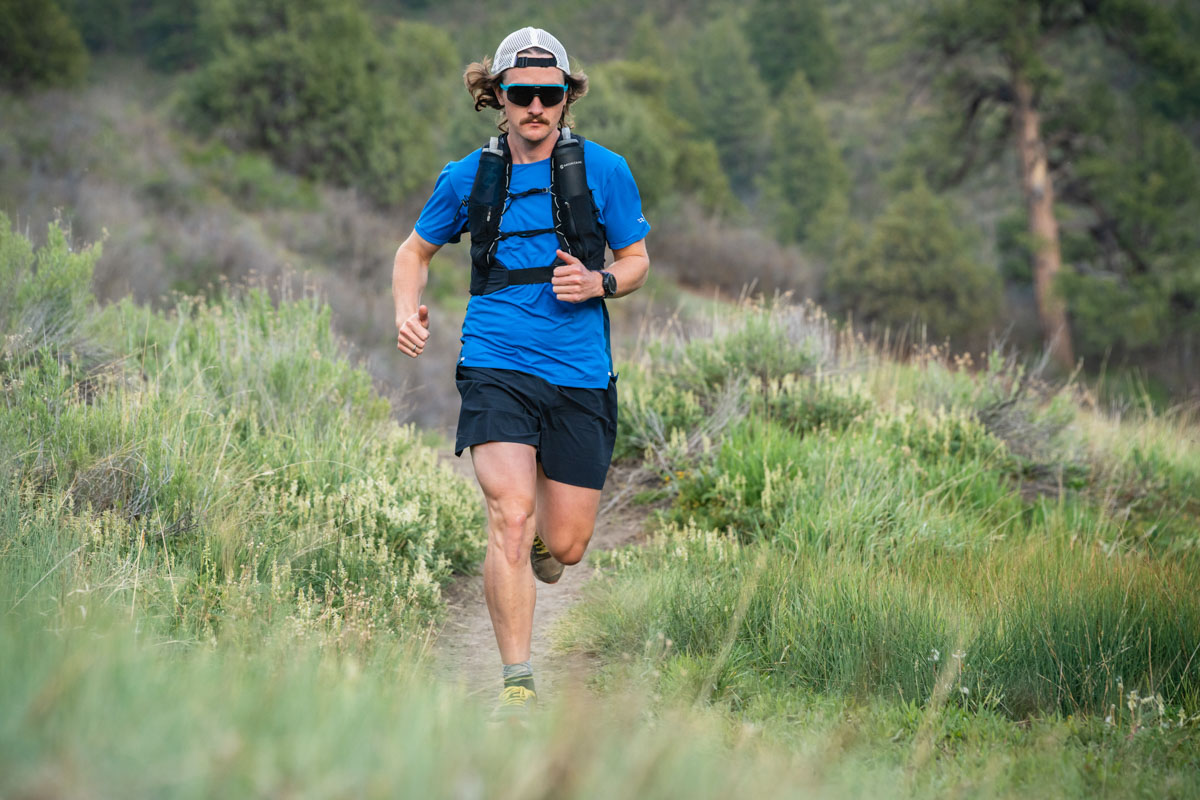
The iRunFar team tested running vest from a variety of companies with many different designs. Photo: iRunFar/Eszter Horanyi
Clasps and Closure System
A running vest’s chest strap closure system is a small detail that significantly impacts fit and functionality. Although our favorite packs vary somewhat in their closure systems, simplicity and ease of use are the most important features of any system. In the case of the USWE Pace 8L Trail Running Vest, one single large buckle centered on the chest is about as simple as it gets!
The most common chest strap closure is a simple buckle, similar to a traditional backpack sternum closure. These are easy to use and typically do not require much focus or dexterity, which is important for cold fingers and tired brains.
The Osprey Duro 1.5 and the Osprey Dyna 1.5 employ a slightly different variation of the plastic buckle closure, with plastic clips attached to the sternum straps, while the CamelBak Zephyr Pro Vest has simple buckles.
Another commonly used chest strap closure is a cord that stretches across the chest and attaches to a plastic hook. The strap adjusts by pulling the cord through a bungee clasp system to tighten and loosen it as needed. The Salomon Adv Skin 12, Salomon Adv Skin 5, UltrAspire Alpha 6.0 Race Vest, and the UltrAspire Spry 5.0 Race Vest use some form of this closure. This system’s adjustability on the fly and ability to stretch with chest expansion while breathing set it apart from traditional strap options. These closures require a bit more dexterity to align the strap over the hooks and thus can be tricky in very cold conditions or while wearing gloves.
Durability
Hydration packs are expensive and a significant investment for most runners, but they should last a long time. A pack’s durability depends on the fabric, clasps, and cords used in its construction, as well as your use and care.
Depending on where it happens, a zipper, pocket, or clasp failure could range from a minor inconvenience to a catastrophe. Someone who runs on remote mountain ridges or goes bushwhacking through trees and rocky terrain will have different durability requirements for a pack than someone who mostly runs on gravel roads.
As with many other pieces of trail running and outdoor gear, when material weights decrease, durability also tends to decrease. The UltrAspire Alpha 6.0 Race Vest has slightly heavier material than many of the other packs in this guide, but we’ve never worried about it standing up to anything we throw at it.
All the packs we tested fared well in terms of durability, with no significant tears or breakage during our testing period. Our testers have used some packs for years and years without any durability issues.
Extra Features on the Best Running Vests
Many thoughtful details have gone into designing and constructing the best running vests. In addition to the pocket layout, materials, and fit, several additional features enhance the safety and functionality of a pack.
- Whistle — Most of the best running vests today, including the Osprey Duro 1.5 and the Osprey Dyna 1.5, have a whistle, most often attached to one of the front straps by a loop or cord. These tuck into an adjacent pocket to stay secure, yet are easily accessible when needed in an emergency. This small and simple accessory can significantly impact what happens if you are lost or injured and need to summon help. Many races include a whistle as part of their mandatory kits.
- Trekking pole holders — Trekking poles have become a staple at mountain races and ultramarathons around the globe, and running hydration packs have a variety of ways to store poles when not in use, including front- and rear-mounted options. These are often elastic or bungee attachments that cinch poles in place, allowing easy access when needed. You can also add a quiver to the back of your pack or opt for the CamelBak Zephyr Pro Vest, which includes a removable and stowable quiver.
- Cellphone pocket — Most people carry a phone while running, and most hydration packs have a pocket that fits even larger phones. In some cases, these pockets are water-resistant, and other packs have pockets with a zipper or cinch cord to keep the phone secure.
- Attachments for ice axes or helmets — Ice axe loops or helmet attachments are uncommon among most smaller-capacity running-specific packs, but may be an integral accessory for runners who frequent mountainous alpine terrain. Higher-capacity packs — like fastpacks — tend to include these sorts of features.

iRunFar’s Meghan Hicks wears a Salomon pack that can fit a day’s worth of food and cold weather gear. Photo: iRunFar/Eszter Horanyi
Why You Should Trust Us
For the initial version of this guide, our testing process began with extensive research into the running hydration packs and vests available today. After compiling a list of over 130 packs ranging from small to large, we narrowed our list to 25 running packs for intensive testing.
We spent several months packing water and gear into our packs and hitting the trails, from humid U.S. East Coast ultramarathons to high-elevation mountain terrain in Colorado and everything in between. Our testers ran dirt roads to rocky ridgelines, running fast, flat miles and scrambling slowly along ridgelines.
We know that runners have various pack needs for different situations, so we tested options that would work well for urban runs or short races to those that could hold everything we’d need for big days in remote areas.
Whether we had a pack out on a short recovery run or a long romp in the desert where we had it filled with as much water as it could carry, we were constantly assessing the wearability and functionality — especially whether or not we could get to everything we needed easily without having to take the pack off and dig through it.
Our team assessed each pack’s fit, pocket layout, ease of use, comfort, style, weight, breathability, pole-carrying ability, and durability. We also considered the flasks and/or bladders they came with, and any extra features. Testers took the packs in all weather conditions, from hot and dry to cold and rainy, and everything in between, to see if we’d overheat or if the fabric got saggy when wet.
We continue to test new packs as they come on the market so that we can keep this guide updated and make it as easy as possible for you to find the best running vest for your specific needs.

Our testers ran in running vests in a variety of settings, including the Santa Monica Mountains. Photo: iRunFar/Eszter Horanyi
Frequently Asked Questions About the Best Running Vests
When should I run with a vest?
If you need more gear than what will fit in your pockets or a running belt, it’s time to consider a running vest. This may be for an hour-long run in the heat or a race with a significant mandatory gear list. For shorter outings, a small pack, like the Osprey Duro 1.5 or the Osprey Dyna 1.5, can easily carry essentials and keep you from stuffing too many items into pockets. Carrying a pack is also an easy way to keep your hands free, which many of us prefer, even for short runs.
Runs in more remote locations or rugged terrain may require extra gear, like a first-aid kit, trekking poles, and additional layers. Any multi-hour adventure and almost all ultramarathon races will require a pack to carry the gear, food, and water needed for a safe and comfortable day on the trails.
What capacity hydration pack do I need?
Smaller capacity packs in the one- to five-liter range, including UltrAspire Spry 5.0 Race Vest, Patagonia Slope Runner Vest, Salomon Adv Skin 5, and the Osprey Duro 1.5 and Osprey Dyna 1.5, are perfect for shorter runs and races where minimal gear and hydration are needed. These scenarios include two-hour runs, well-supported ultramarathons with frequent aid, or a two- to four-mile repeating loop course where you may not want a bottle in your hand the entire time but don’t need to carry hours’ worth of nutrition or gear. In these situations, you may consider wearing a running belt instead, and you can explore more options in our Best Running Belts guide.
A mid-capacity pack in the 6- to 11-liter range, like the UltrAspire Alpha 6.0 Race Vest, will give you extra storage space for food, fluids, and layers to extend your unsupported running time. For all-day runs or high-mountain adventures requiring multiple extra layers and safety equipment, a high-capacity 12-liter pack are the way to go.
Most of the higher-capacity packs feature lightweight, stretchy materials that fit close to your body when not full, so if you need one pack to take you through both your two-hour training runs and your ultramarathon on race day, larger vests will expand to fit gear and also wear comfortably when not stuffed to the gills. The Salomon Adv Skin 12 was our favorite of the larger-capacity packs we tested, as it felt good whether it was mostly empty or completely full.

The zippered phone pocket of the Salomon Adv Skin 12 is big enough for nearly all phones. Photo: iRunFar/Eszter Horanyi
How should my running vest fit?
Your pack should fit snugly against your body and not shift or bounce with movement. A bouncing pack is both uncomfortable and can cause chafing. You will want enough room in the arms to have an unrestricted arm swing and enough space in the chest to tighten the sternum straps to secure the pack, but not restrict breathing. The Salomon Adv Skin 12 is an excellent pack that will fit snugly regardless of how full it is.
The best running hydration packs sit high on the back and torso, though your pack should not feel tight around your chest or armpits. The UltrAspire Alpha 6.0 Race Vest sits a bit lower on the body than the rest of the packs in this guide. All pack manufacturers included in this buyer’s guide have a size chart and instructions for taking proper measurements to ensure an accurate fit. We recommend using these guides and trying packs on in a specialty running store, if possible.
What should I carry in my running vest?
While the name implies that runners primarily use hydration packs to carry water, most use them to carry an array of items in addition to liquid. Once you square away your fluids in soft flasks, bottles, or a bladder, you will want to consider the other items you want on hand while out on a run or race. Food, energy gels, and electrolyte powder are common items stashed in the easy-to-access pockets in running vests.
Depending on the weather, a hat, a pair of gloves, a buff, a jacket, or an extra layer may be in order. An emergency blanket and small first-aid kit are never a bad idea to have on hand. At the very least, some band-aids, anti-chafe cream, and tape will help in a pinch.
A cellphone for safety, music, and photos is a must-have for most of us, and a small external phone charger may also make the cut for long days, especially if using a phone for navigation. The gist is that hydration, food, and safety should always be at the top of your packing list. A pack like the Salomon Adv Skin 12 will carry everything you need for a full day in the mountains.

The front pockets of the Salomon Adv Skin 12 line of vests have been some of the best on the market for a long time. Photo: iRunFar/Eszter Horanyi
Is there a difference between men’s and women’s running vests?
For a few years, there was a push from several brands to make women-specific hydration packs with different pocket configurations and sizes than the unisex packs. In many of these cases, the women’s version was less functional with smaller and more awkward pockets, and our women testers generally preferred the unisex options.
This information seems to have made it back to design teams, as there seems to be less variation in the unisex and women-specific vests. Salomon, notably, has redesigned the pockets on the women’s version of the Salomon Adv Skin 12, as well as the smaller Salomon Adv Skin 5.
Several of the vests in this guide have both a unisex and women’s version with similar pocket designs, including the CamlBak Zephyr Pro Vest. The layout between the unisex and women’s vest is similar, but they have slightly different torso shapes and sizes. The Osprey Duro 1.5 and Osprey Dyna 1.5 are also a unisex and women-specific versions of the same pack, with only minor differences in fit and no difference in functionality.
We always recommend that runners choose the layout, setup, sizing, or color that suits them the best, regardless of how it’s labeled.

Running vests come in all shapes and sizes to fit any body and any need. Photo: iRunFar/Eszter Horanyi
Should I carry my liquids in bottles, soft flasks, or a hydration bladder?
This is a matter of personal preference and may take some experimenting to see which setup you prefer. For faster runs or races where quick aid station turnaround is important, a flask or bottle is much easier to remove, refill, and replace than a bladder.
For hot days or long runs, a bladder may be preferable for its additional volume, or a combination can ensure adequate liquid capacity. A pack like the Salomon Adv Skin 12 can easily carry three liters of liquid between a bladder and soft flasks.
What are the best hydration packs for larger chests?
Women and men have different torso shapes, and several running vests have a women’s option that considers this. The sternum strap configuration and shoulder strap shape are the main factors affecting comfort over larger chests.
Sternum straps that are easy to adjust and have some stretch, like those of the Salomon Adv Skin 12, will be more comfortable than a rigid or fixed-position strap, which may lead to increased pressure on sensitive areas.
While multiple packs have design elements to fit women’s bodies better, the most important factor to consider is what is most comfortable for you. A larger-sized unisex pack may be a better fit than one marketed as women-specific, so some trial and error and a good return policy may be worth prioritizing.
Brands seem to be turning away from changing the pocket configuration in women-specific vests, but the women’s versions of the CamelBak Zephyr Pro Vest has a shape better-suited to women’s bodies.
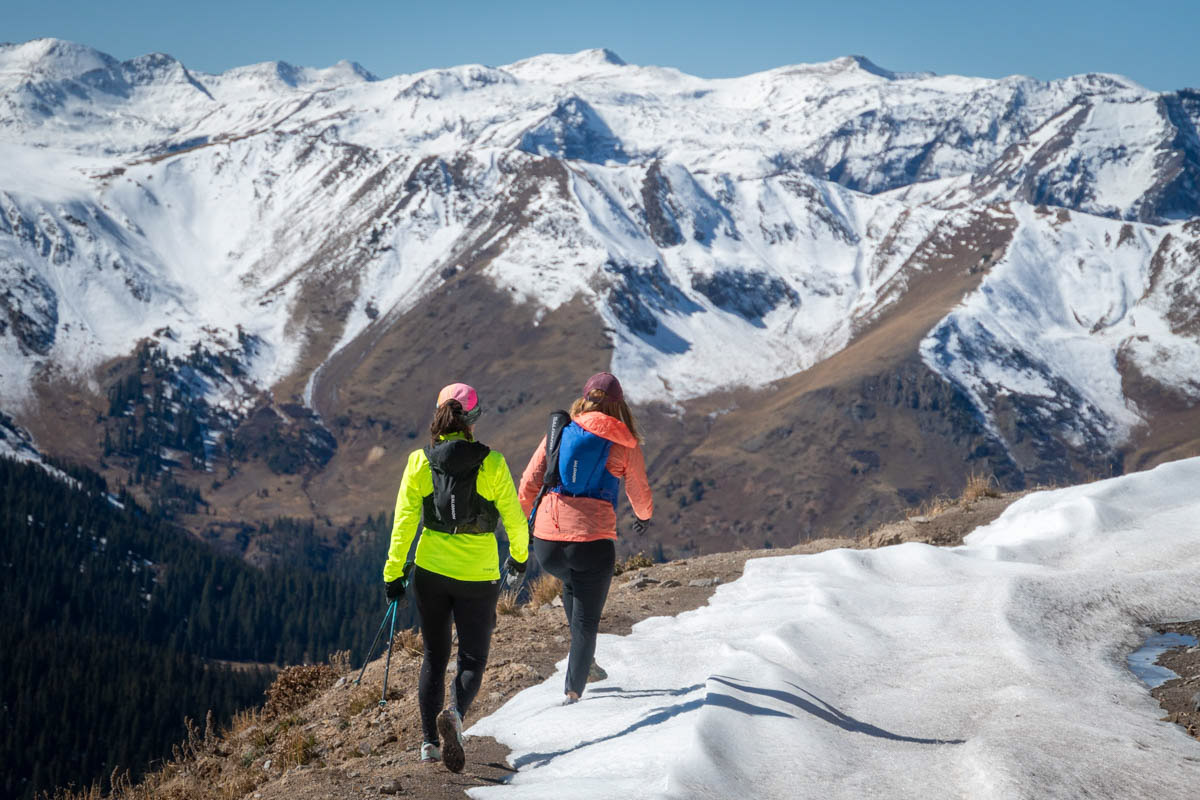
You want to choose a vest with enough capacity to fit everything you need, whether you’re racing or out on an all-day mountain adventure. Photo: iRunFar/Eszter Horanyi
Which running vest is best for cold-weather running?
Hydration packs often provide the added benefit of keeping the core warm when running in cold weather. The downside is that they can cause your back and chest to get sweaty, which we recommend avoiding, especially in the cold.
Some packs, like the UltrAspire Alpha 6.0 Race Vest, have an insulated pocket for a bladder to protect the water from the cold. Also, if you’re running in sub-freezing temperatures, you’ll want to ensure the water in your bladder hose doesn’t freeze. To do this, when finished drinking, blow any water in the hose back into the bladder to keep it from freezing in place.
What’s the best way to attach trekking poles to a hydration vest?
Unless you’re doing a race or a run straight up a hill, you’ll probably want a way to stow your trekking poles when they are not in use. There are several different attachment systems for trekking poles on various packs, and it comes down to personal preference for which you prefer.
A pack like the UltrAspire Alpha 6.0 Race Vest has an elastic cord on the bottom that allows you to attach poles horizontally across your lower back. Other packs can attach the poles vertically along the front of the pack, a design we don’t recommend due to the potential for injury if you fall.
The Salomon Adv Skin 12 has multiple pole attachment options, and many runners choose to attach a pole quiver to their pack to store their poles easily. The CamelBak Zephyr Pro Vest includes a quiver for carrying poles.
Call for Comments
- What is your favorite running vest?
- Which running vest feature is a must-have?


